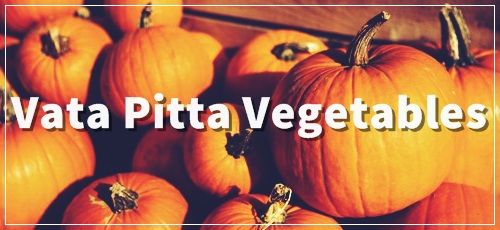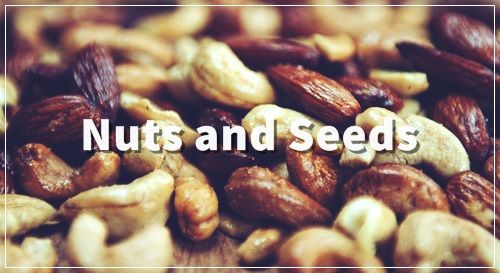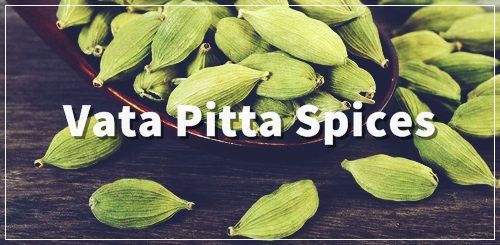The interesting thing about managing such dual dosha types (and dual doshas are very common) is that the foods, which pacify the one, may aggravate the other, and this was […] The post Vata Pitta Diet: Principles, Food List...
The interesting thing about managing such dual dosha types (and dual doshas are very common) is that the foods, which pacify the one, may aggravate the other, and this was already mentioned in the post about Vata Kapha diet.

So, here we have Vata, which is cold, so it requires hot foods, and we have Pitta, which is, in contrast, a hot dosha, and consequently needs some cooling meals.
When the Vata is in balance, its digestion will be more or less fine, because it will be supported by this dosha just like the fire is fed by the inflow of air.
But when the air blows unevenly, the same happens to the fire – so when there is Vata dosha imbalance, the digestion goes haywire (it doesn’t become strong usually, but rather weak or irregular).
Pitta will naturally support the digestive fire (Agni), when it’s balanced; but imbalanced Pitta will give your either strong uncontrolled hunger or indigestion (because it is a combination of fire and water, so there can be too much of fire, or too much of water element, when the Pitta is aggravated).
Now, if I’m a Vata Pitta person, what should I do with all this?
The art here is to eat in such a way so that you won’t aggravate any of the two. But it’s easier said than done, since there are no such foods that fit both doshas equally well.
The main thing here is to learn to listen to your body – this will give you the ability to know when and which of the two doshas became imbalanced, and which foods are the best to consume to bring it back to a peaceful state.
How to learn to listen to my body?

1. Be conscious of your eating process: don’t be distracted to various stimuli while eating, but rather put all your attention to your meals and how you consume them, what is the taste, smell, etc.
It takes some time and practice, but in the end, you will be able to better understand what’s going on within your body when you eat some certain type of food, how various products are combined (or should not be combined), etc.
2. The second way that nicely worked in my case (and in the case of other people, who did it) is the regular yoga practice.
What has yoga to do with all this? Firstly yoga and ayurveda are called sisters, because they complement each other.
Secondly, a regular practice of yoga poses brings harmony to your body and mind, which results in your better understanding of the both, including the internal processes within them, and the food influence on these two as well.
In short, it means, that when you start doing yoga on a regular basis, after some time you will be able to feel what to eat and when to eat naturally.
OK, now let’s see, what are the best foods for Vata Pitta dosha.
Pitta Vata Food List
By the way, the following products are suitable for both combinations: VP or PV, hence the Pitta was placed first in the subtitle above – simply for a change.  So, we could also say ‘Vata Pitta food list’ and still you will get the same enumeration of foods. The only thing to keep in mind is that if one of these two doshas is more prominent, you need to consider its qualities more over the other one when preparing your meals.
So, we could also say ‘Vata Pitta food list’ and still you will get the same enumeration of foods. The only thing to keep in mind is that if one of these two doshas is more prominent, you need to consider its qualities more over the other one when preparing your meals.

Below are important notes that were used in Vata dosha food list article. Please, keep an eye on the asterisks (will be right after the certain foods).
Cereals
Whole grains are the best, and should be cooked; bread is better un-yeasted.
Best: cooked oats, wheat (can be whole wheat and wheat porridge), white long grain rice (Basmati is the best).
Small amounts: amaranth, barley, quinoa, millet, short-grain rice, brown rice, rye.
Minimize: corn, buckwheat.
Vata Pitta Fruits
The best fruits are those that are sweet and ripe; but since they are considered to be light food, consume them in moderation.
Best: avocado, apricots, blackberries, ripe bananas, cantaloupe, blueberries, figs, dates, coconuts, sweet mango, nectarines, sweet oranges, peaches, sweet papaya, sweet plums, raisins, prunes, strawberries, raspberries.
Small amounts: grapes, pears, persimmons, pomegranates, apples, bananas, cherries, limes, grapefruit, cranberries, pineapple, watermelon (better with little salt and black pepper), tangerines.
Minimize: oranges, dry fruits, sour fruits.
Vata Pitta Vegetables

Cooked vegetables are the best, because they are easier to digest. Do not indulge in eating raw veggies too much, since they aggravate Vata dosha.
If your digestion is strong enough, you can eat raw salads and leafy greens during summer. But reduce the amount of these foods if you experience gas or constipation.
Best: cilantro, bottle gourd, okra (cooked in oil), pumpkin, squash (winter squash, zucchini, etc.), sweet potato.
Small amounts: potato, seaweed, carrot, beets, asparagus, bean sprouts (steamed or sautéed, but not raw), bell pepper (yellow and red), bitter melon, broccoli, cauliflower, Brussels sprouts, celery, eggplant, cucumber, kale, raw lettuce, mustard greens, parsley, spinach, sour tomato, turnip.
Minimize: green bell pepper, cabbage, artichoke, chilli, hot pepper, radishes, raw onion.
Legumes
The main problem is that the most legumes aggravate Vata. To make them work, one has to soak legumes in water for few hours or overnight before cooking, and cook them with coriander and cumin.
Best: mung beans.
Small amounts: black gram, navy beans, black lentils, adzuki beans, pinto beans, split peas, tofu, chickpeas.
Minimize: dried peas, soy beans, fava and kidney beans.
Nuts and Seeds

These are quite good for Vata Pitta, but are better digested, when soaked in water for 8 hours before consumption. Nut butter can also be eaten, but avoid or minimize peanut butter – it’s too heavy for this dosha combination.
Nuts and seeds can serve as great Vata Pitta snacks, if the digestion is generally strong enough. Pre-soaked dry fruits are also good for snacking.
Best: almonds, cashews, tender coconuts, pine nuts, and sunflower seeds.
Small amounts: Brazil nuts, macadamia, lotus seeds, pistachio, pecans, pumpkin seeds.
Minimize: peanuts.
Oils for Vata Pitta
Healthy oils in generous amounts are a must in your diet, especially, if you suffer from constipation and excessive skin dryness.
Best: ghee, sesame, olive, avocado, coconut, sunflower oil.
Small amounts: almond, castor, flax seed, corn, soy oil.
Minimize: canola, peanut, mustard, safflower, margarine.
Vata Pitta Spices and Balancing Herbs

Spices are generally good for this body type, but be careful with the hot ones, when your Pitta is out of balance.
Best: cardamom, caraway, catnip, cilantro, chamomile, cumin, coriander, fennel, lemongrass, saffron, rosemary, turmeric, spearmint.
Small amounts: dill, cinnamon, basil, anise, fenugreek, fresh ginger, nutmeg, marjoram, poppy seeds, oregano, sage, star anise, thyme, black pepper, salt.
Minimize: cayenne, asafoetida (hing), cloves, dry ginger, horseradish, raw garlic, hot mustards.
Drinks
All the drinks are the best taken at room temperature or warm, but never ice cold – it will destroy your digestion, and aggravate Vata quickly.
Best: chamomile and licorice tea, coriander and mint tea, mildly spiced teas, and water.
Small amounts: fruit juices (especially diluted) and juice beverages, buttermilk, naturally flavored soda, green tea, tomato juice.
Minimize: coffee (caffeinated and decaffeinated) and alcohol (this one is better dropped completely), soft drinks, black tea, green vegetable juices.
So, if you consider these foods when planning your Vata Pitta dosha diet, your digestion will remain quite strong (at least as much as it is possible for this combination), you will experience less gas, bloating and constipation, and the elimination will become more regular.
An Example of Vata Pitta Meal Plan

It’s always difficult to give a sample Vata Pitta menu, because there are so many factors to be considered, including the availability of certain foods, and the current health condition of a person.
But anyway, let’s try to get at least some idea of what to refer to.
Vata Pitta Breakfast
Breakfast should be there for sure, but it should never be heavy, should never consist of only raw foods, leftovers from the yesterday’s meals, or very refined foods (like bakery products made from high-grade flour).
The best options would be cereal with milk or milk substitutes, like almond or coconut milk, or just cooked in water.
Some small amount of pre-soaked dry fruits or nuts can also be consumed, but not in large quantities.
Some hot herbal tea is also welcomed.
The whole idea of the breakfast for Vata Pitta is to give enough nourishment, but without overloading the digestion.
Vata Pitta Lunch
Lunch should be nutritious and grounding – it’s the largest meals of the day, and the best time to have it is between noon and 2 pm.
Rice, wheat, moong beans, (other pulses can be there too), cooked vegetables, a small amount of raw salad, cereals, sweet potato, soups, etc. – are the best choices for lunch.
As for the drinks, you can either have hot herbal tea, or simply plain, hot (boiled) water to sip while you eat.
Vata Pitta Dinner
For dinner you can have the same foods you had for lunch, but in smaller amounts. Have your dinner around 6-7 pm.
If you experience gases after eating beans and lentils, soak them before cooking and cook or eat with such spices as coriander, cumin and a little bit of lemon juice.
Don’t eat too much of beans and lentils at a single meal since they are difficult to digest; and always chew every bit of your food thoroughly (around 30 times each piece you put into your mouth).
To aid digestion, you may chew a teaspoon of a mixture, composed of slightly roasted fennel seeds and a little amount of sugar crystals.
If you feel the need to eat something before going to bed, you may have a glass of milk boiled with few raisins, and with a teaspoon of ghee or almond oil added to it. It will pacify your Vata and promote sound sleep.
So, this was just an example of Vata Pitta diet plan, you can try following; feel free to adjust it to your needs. When you learn to listen to your body, everything will become much easier in terms of what and when to it, and which foods to combine. There are many recipes available online, so you can try using them and see if they work well for you.
Tips for Vata Pitta Pacifying Diet

These tips will help you make your Vata Pitta food program more efficient. Some of them you may have already heard, but it will be a good reminder, nevertheless.
We mentioned already, then you need to see what dosha is more prominent right now, and choose your foods accordingly. But what to do, when the doshas are more or less equal?
Here the principle is this: follow the Vata dosha diet in the first place, which means eating warm, freshly cooked and easily digestible food. But to avoid disturbing your Pitta, this food should be low on sour and pungent tastes, low on spices, and should contain some ingredients with the cooling qualities – a plate of rice with cooked zucchini can serve as a good example (even if it is hot, still it won’t aggravate Pitta).
Another important point is to completely avoid frozen foods. Although they will cool the fiery Pitta, they will severely aggravate Vata. You need to warm the frozen stuff, but still it is not the best meal option for your Ayurvedic constitution.
Avoid eating too much of raw foods – certainly, they are essential and healthy, but they will disturb your Vata as well. So, eat them in smaller quantities, seasoned with suitable oils and spices.
Coconut water, sweet lemonade, sweet buttermilk, sherbets, and similar natural drinks that are sweet and cool, can be consumed during hot summer. But even in this case, these drinks should be served without ice or should not be icy cold. Smoothies are OK within certain limits.
The strategy for Pitta Vata eating plan is based on two principles: regular meals and small servings. These two will help maintain your appetite, digestion and elimination stable. And this stability in having meals and small quantities of food will also help to avoid or minimize a common problem – Vata Pitta constipation.
Constipation is a symptom of Vata dosha imbalance, but fighting it with laxatives, even with the natural ones is not a strategic decision, because the majority of laxatives tend to weaken the intestines, and after their use the constipation is often inevitable.
Of course, sometimes these remedies can be used, especially the mild ones, such as Triphala. But the best course of action is to regulate your food intake in such a way, so that your digestion and elimination will work like clockwork (well, maybe not literally, but close to it – at least that is what I can tell from my own experience, since I happen to be Vata Pitta dosha myself).
According to Ayurveda, how you eat is as important as what you eat. Eating slowly and in a peaceful atmosphere will greatly improve the digestion – and it is an observable fact.
But if you eat in haste, while walking, standing, talking or working, chances are you will get poor digestion, gasses and acidity.
Liquids are a tricky thing; they are definitely required, but you shouldn’t drink them just whenever you want. The best time for them is an hour before or an hour after meals to avoid the dilution of the digestive juices. But you can also sip some liquids during the meals – it works quite well for me.
The best spices to use are cumin, fennel, turmeric, coriander seeds and ginger (in smaller quantities, since it is hot in nature).
Lightly cooked foods are better that raw; you still need some raw foods but take them during lunch, preferably in the very beginning of your meals, and in smaller amounts.
Oil and ghee should be used in cooking or/and while eating to lubricate Vata. If you notice that you are gaining weight, limit oil consumption to 6-8 teaspoons per day, but don’t drop it completely. Ghee (clarified butter) is good for all doshas.
Eating yogurt is OK, but it’s better to have it plain and natural, and add some fruits in it. However, don’t eat yogurt everyday and never before going to bed.
Remember, that the best tastes for Vata dosha are sweet, sour and salty, and you need to minimize astringent, pungent and bitter taste. Vata can become aggravated quite easily, so we need to consider it in the first place.
Pungent, salty and sour tastes aggravate Pitta, and bitter and astringent pacify it, but give the preference to these tastes only if you feel that your Pitta is going out of balance; otherwise prefer those that fit Vata.
Sweet taste is fine for both doshas, but don’t use white refined sugar or sugar based sweets as a source for sweet taste, since sugar is not good for Vata dosha. The same thing is with high-grade white flour.
It doesn’t mean you need to avoid white sugar completely – just minimize it as much as possible.
The best alternatives are unrefined sugar, fruits and other natural sweets.

Also, according to Ayurveda, the following foods also have sweet taste: rice, wheat, barley, zucchini, squash and tapioca. It may not be that obvious, since we so accustomed to concentrated sweets made of refined sugar, but when we start eating less of these, we become more sensitive to a subtle sweetness from natural foods, like rice, etc.
So, essentially, that’s all the main things about Vata Pitta diet and the food list for this dosha combination.
The post Vata Pitta Diet: Principles, Food List and Meal Plan first appeared on Yoga Yukta.










